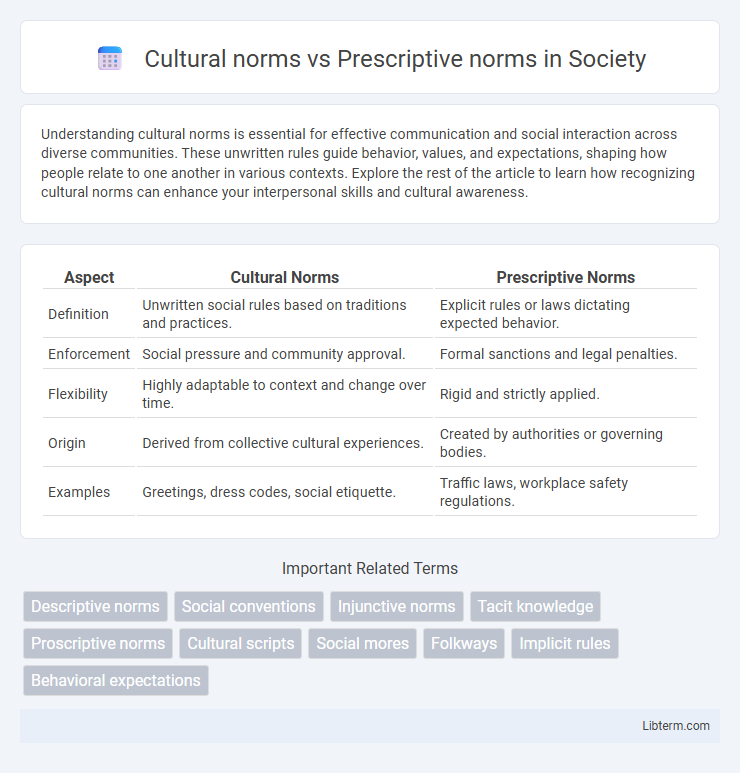Understanding cultural norms is essential for effective communication and social interaction across diverse communities. These unwritten rules guide behavior, values, and expectations, shaping how people relate to one another in various contexts. Explore the rest of the article to learn how recognizing cultural norms can enhance your interpersonal skills and cultural awareness.
Table of Comparison
| Aspect | Cultural Norms | Prescriptive Norms |
|---|---|---|
| Definition | Unwritten social rules based on traditions and practices. | Explicit rules or laws dictating expected behavior. |
| Enforcement | Social pressure and community approval. | Formal sanctions and legal penalties. |
| Flexibility | Highly adaptable to context and change over time. | Rigid and strictly applied. |
| Origin | Derived from collective cultural experiences. | Created by authorities or governing bodies. |
| Examples | Greetings, dress codes, social etiquette. | Traffic laws, workplace safety regulations. |
Understanding Cultural Norms: Definition and Examples
Cultural norms are shared expectations and rules guiding behavior within a specific community or society, often unwritten and evolving through social interaction. Examples include greetings like bowing in Japan or shaking hands in the United States, reflecting collective values and traditions. Understanding these norms helps navigate social situations, fostering respect and cohesion by aligning individual behavior with group practices.
What Are Prescriptive Norms? Key Characteristics
Prescriptive norms refer to explicit rules or guidelines dictating acceptable behavior within a group or society, often formalized through laws, policies, or institutional regulations. Key characteristics of prescriptive norms include their clear articulation, enforceability through sanctions or rewards, and their role in maintaining social order by promoting conformity to established standards. Unlike cultural norms, which are informal and evolve organically, prescriptive norms are deliberately created and communicated to guide behavior in specific contexts.
Differences Between Cultural and Prescriptive Norms
Cultural norms are informal rules shaped by shared values and practices within a community, reflecting collective behaviors and traditions. Prescriptive norms, in contrast, are explicit guidelines or laws that dictate specific behaviors that individuals are expected to follow. The key difference lies in adaptability; cultural norms evolve organically over time, whereas prescriptive norms are formally established and enforced to regulate conduct.
Origins and Evolution of Cultural Norms
Cultural norms originate from long-standing traditions, social rituals, and collective practices within communities, evolving organically over generations to guide everyday behavior. Unlike prescriptive norms, which are explicitly codified rules imposed by institutions or authorities, cultural norms develop informally through shared experiences and mutual understanding. Their evolution reflects historical events, environmental adaptations, and intercultural interactions that continuously shape societal expectations and values.
The Role of Prescriptive Norms in Shaping Behavior
Prescriptive norms serve as explicit guidelines that dictate appropriate behavior within a society, reinforcing compliance through social approval or disapproval. These norms influence individual actions by establishing clear expectations, often backed by formal rules or laws, which shape social interactions and group cohesion. Unlike cultural norms, which are more implicit and variable, prescriptive norms provide a standardized framework that drives consistent behavioral patterns across diverse contexts.
How Cultural Norms Influence Social Interactions
Cultural norms shape social interactions by establishing shared expectations and behaviors within a community, guiding individuals on acceptable conduct and communication styles. These unwritten rules influence nonverbal cues, conversational patterns, and conflict resolution methods, fostering social cohesion and mutual understanding. Unlike prescriptive norms, which are formalized rules or laws, cultural norms evolve organically and vary widely across different societies.
Enforcement and Consequences of Norm Violations
Cultural norms are informal guidelines enforced through social approval or disapproval, with consequences such as ostracism or loss of reputation within a community. Prescriptive norms, often codified in laws or organizational rules, carry formal enforcement mechanisms like fines, penalties, or legal action for violations. The severity and type of consequences depend on the norm's nature, with prescriptive norms typically having more explicit and structured enforcement compared to the socially driven enforcement of cultural norms.
Case Studies: Cultural vs. Prescriptive Norm Conflicts
Case studies reveal that conflicts between cultural norms and prescriptive norms often arise in multinational corporations where local customs clash with formal organizational policies, leading to compliance challenges and ethical dilemmas. For example, in Japan, the cultural norm of group harmony may conflict with Western prescriptive norms emphasizing individual accountability and transparency in decision-making. These conflicts necessitate adaptive management strategies that respect cultural values while enforcing universal standards to ensure cohesive and ethical workplace behavior.
Adapting to Changing Norms in Modern Societies
Cultural norms represent the shared values and practices organically developed within societies, while prescriptive norms are explicitly established rules or guidelines dictating acceptable behavior. In modern societies, adapting to changing norms requires balancing traditional cultural expectations with evolving prescriptive standards influenced by globalization, technology, and social movements. This dynamic process promotes social cohesion and innovation by allowing flexibility in behavior while maintaining communal order and respect.
The Future of Norms: Blending Culture and Prescription
The future of norms lies in the dynamic integration of cultural norms, which are socially shared expectations shaped by tradition, and prescriptive norms, which are formal rules established by authorities. This blend fosters adaptive frameworks that balance community values with regulatory precision, promoting harmonious social order and innovation. Emerging technologies and globalization accelerate this convergence, necessitating norm systems that are both culturally sensitive and prescriptively clear.
Cultural norms Infographic

 libterm.com
libterm.com